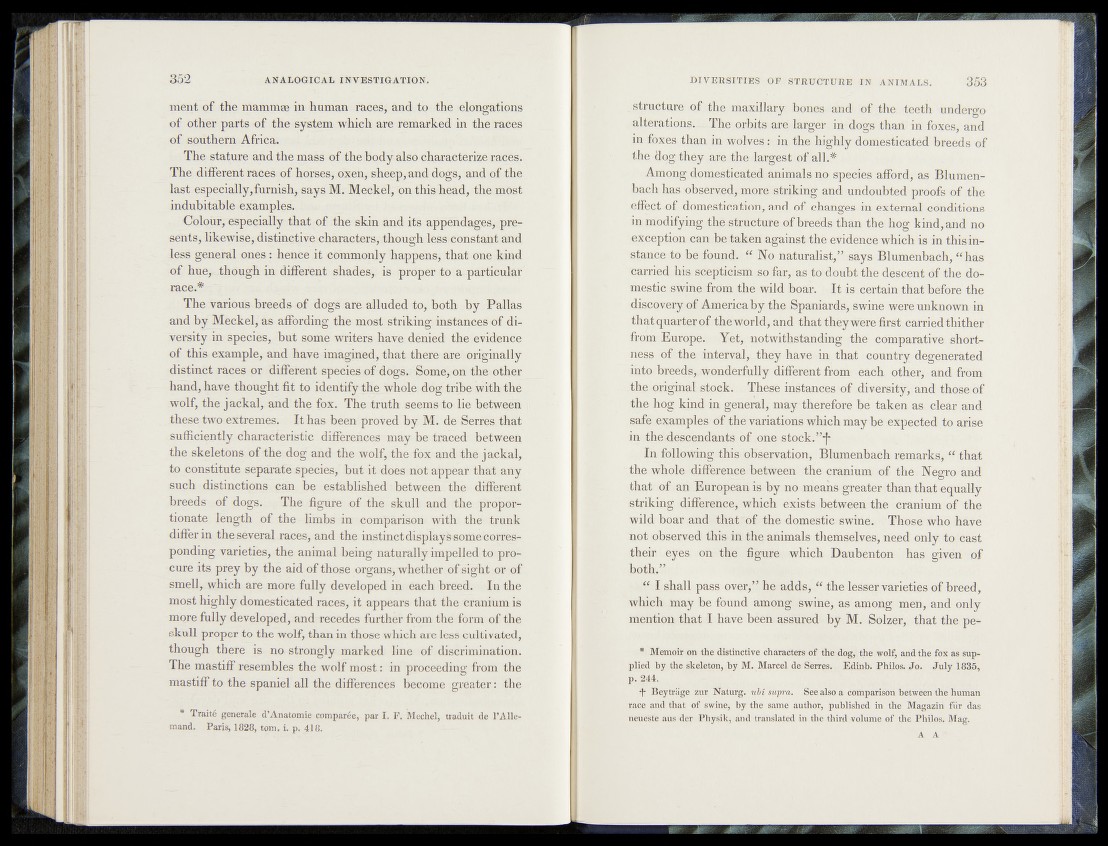
ment of the mammae in human races, and to the elongations
of other parts of the system which are remarked in the races
of southern Africa.
The stature and the mass of the body also characterize races.
The different races of horses, oxen, sheep, and dogs, and of the
last especially,furnish, says M. Meckel; on this head, the most
indubitable examples.
Colour, especially that of the skin and its appendages, presents,
likewise, distinctive characters, though less? constant and
less general ones : hence it commonly happens; that? One kind
of hue, though in different shades,, is proper to a particular
race.* -
The various breeds of dogs are alluded to, both by Pallas
and by Meckel, as affording the most striking instances of diversity
in species, but some writers have denied the evidence
of this example, and have imagined, that there are*originally
distinct races or different species of dögs.:'Some, on the other
hand, have thought fit to identify the whole dog tribe with the
wolf, the jackal, and the fox. The truth seems to lie between
these two extremes. I t has been' proved by M. de Serres that
sufficiently characteristic differences may be traced between
the skeletons of the dog and the wolf, the fox and the jackal;
to constitute separate species, but it does not appear that any
such distinctions can be established . between. the different
breeds of dogs. The figure of the skull and the proportionate
length of the limbs in comparison with the* trunk
differ in the several races, and the instinct display S^some corresponding
varieties, the animal being naturally impelledito procure
its prey by the aid of those organs, whether oltiigltt or of
smell, which are more fully developed in each breed. In the
most highly domesticated races, it appears that the cranium is
more fully developed, and recedes further from the form of the
skull proper to the wolf, than in those which are less cultivated,
though there is no. strongly marked line of discrimination.
The mastiff resembles the wolf most : in proceeding from the
mastiff to the spaniel all the differences become greater : the
* Traité generale d’Anatomiecomparée, par I. F. Mechel, traduit de l’Allemand.
Paris, 1828, tom. i. p. 418.
structure of the maxillary bones and of the teeth undergo
alterations. —The orbits are larger in dogs than in foxes> and
in foxes than in wolves: in. the highly domesticated breeds of
the dog .they are the .largest,Of all.*
Among domesticated animals no species afford, as Blumen-
bach has observed, more striking and undoubted proofs of the
effect-of, domestication, and of changes in external conditions
in modifying the structure of breeds; than the hog kind, and no
exception can betaken againstthe-evidence which is in thisin-
stance to be found. “ No naturalist,” says Blumenbach, “ has
■carried his, scepticism So .far, as.to doubt the descent Of the domestic
swine from the wild h©ak It is certain that before the
discovery.of Americaby the Spaniards, swine were unknown in
that quarter of the world, arid that they were first carried thither
from Europe.; Yet, notwithstanding the comparative short-
rtes^iof the interval, they have in that country degenerated
into breeds,^wonderfully different from each- other, and from
the .originat stock. These instances of .diversify, and those of
the hog kind in general, ;i$ay' therefore be taken as* clear, and
safe, e^mples" of the variations which maybe expected- to arise
in -thedescendants of one stock.’’*f-
In following this observation, Blumenbach remarks, that
the whole difference between the cranium of the Negro and
that of a» JSuropean is by no-means greater-dhan that equally
striking difference, which exists .between the cranium of the
wild boar and that of the domestic swinev '-I Those who have
not observed this in the animals themselves, need only to cast
their eyes. on the figure which Daubenton has given of
both.”
“ I shall pass overf;’ he add§“>;“ the lesser varieties of breed,
which toay be found among swine, asó|ö»pig men, and only ,
mention that I have been assured by M. 3olzer, that the pe-
• Memoir on. the distinctive characters of the dog, the: wolf, and the fox as supplied
by the skeleton, by;M. Marcel deSerfe^. Edinb. Philos, do, Ju ly 1835,
p. 244.
•f Bey trage zur Naturg. ubi Supfa, • See also a comparison between the human
race and that of swine, by the same author, published in the Magazfn fur das
neueste aus der Physik, and translated in the third volume of the Philos. Mag.